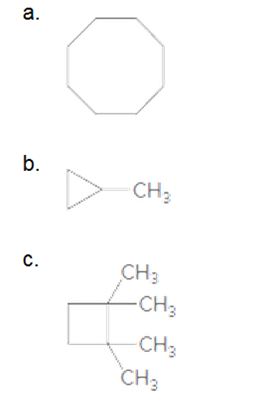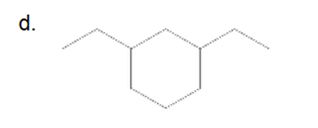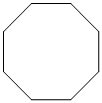
Concept explainers
Give the IUPAC name for each cycloalkane.


(a)
Interpretation:
The IUPAC nomenclature of Cycloalkanes without any branch needs to be determined.
Concept Introduction:
Every organic compound has its own unique name which is followed by the IUPAC (International Union of Pure and Applied Chemistry). For Cycloalkane also, there is a particular rule for IUPAC nomenclature. Some rules are same as for alkanes followed by some new rules. The rules are −
- For all the Cycloalkens, the name will always end with the suffix "−ane.
- Look for the cyclic ring/rings present.
- If more than one ring is there, try to find out the parent cyclic ring. If more than 1 rings are there, then the ring having maximum no. of Carbon will be considered as the parent chain.
- Number the carbons in the parent cyclic ring. Depends on the no. of carbon in the cyclic ring, "Pent (for 5)", "Hept (for 6)" this word will be added before "ane" in the nomenclature. The word 'cyclo' will add before it.
- If any alkyl straight chain is present there and having a greater number of carbons than the cycloalkane, this alkyl chain becomes the primary parent chain. Cycloalkane act as a substituent having an ending "-yl" at the end.
- Branched groups present in the main cyclic ring will be named by counting the number of carbon atoms in the groups. These groups have end in "-yl" (e.g.- propyl, pentyl)
- The position of the group/brunch needs to be noted main cyclic ring. If there is more than one of the same type of branched group then both numbers must be listed (e.g.,5,4 -).
- Numbering of the cyclic ring should start form the Carbon having most priority brunch/group.
- The branched groups need to be listed before the main carbon chain alphabetically (ignoring di/tri).
- Combine the elements of the name into a single word in the following order:
- Branched groups in alphabetical order (ignoring prefixes).
- Add cyclo
- Prefix of main chain
- End with "-ane" suffix.
Answer to Problem 12.51P
Cyclooctane
Explanation of Solution
The parent carbon ring has 8 carbons and no substituents.

So, following by the above mention rule, the name of the alkane is cyclo + oct (8 carbon in parent ring)+ "-ane"= Cyclooctane
(b)
Interpretation:
The IUPAC nomenclature of Cycloalkanes having one branch needs to be determined.
Concept Introduction:
Every organic compound has its own unique name which is followed by the IUPAC (International Union of Pure and Applied Chemistry). For Cycloalkane also, there is a particular rule for IUPAC nomenclature. Some rules are same as for alkanes followed by some new rules. The rules are −
- For all the Cycloalkens, the name will always end with the suffix "−ane.
- Look for the cyclic ring/rings present.
- If more than one ring is there, try to find out the parent cyclic ring. If more than 1 rings are there, then the ring having maximum no. of Carbon will be considered as the parent chain.
- Number the carbons in the parent cyclic ring. Depends on the no. of carbon in the cyclic ring, "Pent (for 5)", "Hept (for 6)" this word will be added before "ane" in the nomenclature. The word 'cyclo' will add before it.
- If any alkyl straight chain is present there and having a greater number of carbons than the cycloalkane, this alkyl chain becomes the primary parent chain. Cycloalkane act as a substituent having an ending "-yl" at the end.
- Branched groups present in the main cyclic ring will be named by counting the number of carbon atoms in the groups. These groups have end in "-yl" (e.g.- propyl, pentyl)
- The position of the group/brunch needs to be noted main cyclic ring. If there is more than one of the same types of branched group then both numbers must be listed (e.g.,5,4 -).
- Numbering of the cyclic ring should start form the Carbon having most priority brunch/group.
- The branched groups need to be listed before the main carbon chain alphabetically (ignoring di/tri).
- Combine the elements of the name into a single word in the following order:
- Branched groups in alphabetical order (ignoring prefixes).
- Add cyclo
- Prefix of main chain
- End with "-ane" suffix.
Answer to Problem 12.51P
Methylcyclopropane
Explanation of Solution
The parent carbon ring has 3 carbons.

And there is only one methyl group in the cyclic ring.
So, following by the above mention rule, the name of the alkane is methyl (the name of the branch, no numbering as only one substituent is there) + prop ( 3carbon in main chain)+ "-ane"= Methylcyclopropane.
(c)
Interpretation:
The IUPAC nomenclature of Cycloalkanes having more than one branch needs to be determined.
Concept Introduction:
Every organic compound has its own unique name which is followed by the IUPAC (International Union of Pure and Applied Chemistry). For Cycloalkane also, there is a particular rule for IUPAC nomenclature. Some rules are same as for alkanes followed by some new rules. The rules are −
- For all the Cycloalkens, the name will always end with the suffix "−ane.
- Look for the cyclic ring/rings present.
- If more than one ring is there, try to find out the parent cyclic ring. If more than 1 rings are there, then the ring having maximum no. of Carbon will be considered as the parent chain.
- Number the carbons in the parent cyclic ring. Depends on the no. of carbon in the cyclic ring, "Pent (for 5)", "Hept (for 6)" this word will be added before "ane" in the nomenclature. The word 'cyclo' will add before it.
- If any alkyl straight chain is present there and having a greater number of carbons than the cycloalkane, this alkyl chain becomes the primary parent chain. Cycloalkane act as a substituent having an ending "-yl" at the end.
- Branched groups present in the main cyclic ring will be named by counting the number of carbon atoms in the groups. These groups have end in "-yl" (e.g.- propyl, pentyl)
- The position of the group/brunch needs to be noted main cyclic ring. If there is more than one of the same type of branched group then both numbers must be listed (e.g.,5,4 -).
- Numbering of the cyclic ring should start form the Carbon having most priority brunch/group.
- The branched groups need to be listed before the main carbon chain alphabetically (ignoring di/tri).
- Combine the elements of the name into a single word in the following order:
- Branched groups in alphabetical order (ignoring prefixes).
- Add cyclo
- Prefix of main chain
- End with "-ane" suffix.
Answer to Problem 12.51P
1,1,2,2-tetramethylcyclobutane
Explanation of Solution
The parent carbon ring has 4 carbons.

And there are four methyl groups in the no. 1 and no. 2carbon. As the branch groups have CH3, it is called 'methyl'. As both the groups are the same, any of the carbon having methyl substituents can be numbered as 1.
So, following by the above mention rule, the name of the alkane is 1,1,2,2 (the position of the branch) + tetramethyl (the name of the branch, tetra for having four methyl groups) + cyclo + but (4 carbon in main chain)+ "-ane"= 1,1,2,2-tetramethylcyclobutane.
(d)
Interpretation:
The IUPAC nomenclature of Cycloalkanes having more than one same branch needs to be determined.
Concept Introduction:
Every organic compound have their own unique name which is followed by the IUPAC (International Union of Pure and Applied Chemistry). For Cycloalkane also, there is a particular rule for IUPAC nomenclature. Some rules are the same as for alkanes followed by some new rules. The rules are −
- For all the Cycloalkens, the name will always end with the suffix "−ane.
- Look for the cyclic ring/rings present.
- If more than one ring is there, try to find out the parent cyclic ring. If more than 1 rings are there, then the ring having maximum no. of Carbon will be considered as the parent chain.
- Number the carbons in the parent cyclic ring. Depends on the no. of carbon in the cyclic ring, "Pent (for 5)", "Hept (for 6)" this word will be added before "ane" in the nomenclature. The word 'cyclo' will add before it.
- If any alkyl straight chain is present there and having a greater number of carbons than the cycloalkane, this alkyl chain becomes the primary parent chain. Cycloalkane act as a substituent having an ending "-yl" at the end.
- Branched groups present in the main cyclic ring will be named by counting the number of carbon atoms in the groups. These groups have end in "-yl" (e.g.- propyl, pentyl)
- The position of the group/brunch needs to be noted main cyclic ring. If there is more than one of the same type of branched group then both numbers must be listed (e.g.,5,4 -).
- Numbering of the cyclic ring should start form the Carbon having most priority brunch/group.
- The branched groups need to be listed before the main carbon chain alphabetically (ignoring di/tri).
- Combine the elements of the name into a single word in the following order:
- Branched groups in alphabetical order (ignoring prefixes).
- Add cyclo
- Prefix of main chain
- End with "-ane" suffix.
Answer to Problem 12.51P
1,3-diethylcyclohexane
Explanation of Solution
The parent carbon ring has 6 carbons.

And there are two ethyl groups in the no. 1 and no. 3 carbons. As the branch groups have CH2CH3, it is called 'ethyl'. As both the groups are the same, any of the carbon having methyl substituents can be numbered as 1.
So, following by the above mention rule, the name of the alkane is 1,3, (the position of the branch) + diethyl (the name of the branch, di for having 2 ethyl groups) + cyclo + hex (6 carbon in main chain) + "-ane"= 1,3-diethylcyclohexane.
Want to see more full solutions like this?
Chapter 12 Solutions
GENERAL ORGANIC+BIOCHEM (LL)W/CONNECT
- Which molecular formula corresponds to a cycloalkane?arrow_forwardWrite molecular formulas for each bicycloalkane, given its number of carbon atoms. Q.) Decalin (10 carbons)arrow_forwardWrite molecular formulas for each bicycloalkane, given its number of carbon atoms Q.Norbornane (7 carbons)arrow_forward
 General, Organic, and Biological ChemistryChemistryISBN:9781285853918Author:H. Stephen StokerPublisher:Cengage Learning
General, Organic, and Biological ChemistryChemistryISBN:9781285853918Author:H. Stephen StokerPublisher:Cengage Learning Introductory Chemistry: An Active Learning Approa...ChemistryISBN:9781305079250Author:Mark S. Cracolice, Ed PetersPublisher:Cengage Learning
Introductory Chemistry: An Active Learning Approa...ChemistryISBN:9781305079250Author:Mark S. Cracolice, Ed PetersPublisher:Cengage Learning

